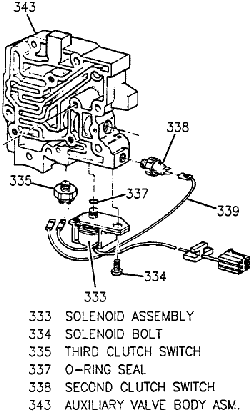Before attempting to diagnose converter clutch electrical problems, mechanical checks such as linkage adjustments and oil level should be performed and corrected as needed.
Generally, if you unplug the TCC solenoid at the transmission and the symptoms go away, you have found the problem. But sometimes this can be misleading because you don't know for sure if it's a bad solenoid, dirt in the valve body or a bad signal from the ECM. The only way to know for certain is to follow the diagnostic procedure as outlined by General Motors. If you follow the test step by step you will be able to determine the exact cause of the problem.
Check For 12 Volts To Terminal A At Transmission.{Presumably at the solenoid- RJ]
Test #6 (Regular Method) Check for ground at terminal D at the transmission.
On Non-computer-controlled vehicles skip this test and go directly to cooler line pressure, or surge test.
Raise the vehicle on the lift so the driving wheels are off the ground.
Unplug the wires at the case and connect the alligator clip of your test light to terminal A.
Place the tip of your test light on terminal D.
Start the engine and bring to normal operating temperature.
Place the selector in Drive. (O.D. on four speed units).
Accelerate slowly to 60 mph and the tester should light.
If the tester does not light you have a computer system problem. Go to test # 7 (Regular Method).
Test #7 (Regular Method)
Ground the D wire at the transmission
Shave a little insulation from or pierce the D wire near the transmission connector. Reseal with silicon.
Connect one end of a jumper wire to the bare wire you just shaved or pierced.
Connect the other end of the jumper wire to ground.
Road test for lock-up (can be done on lift).
If you're not sure if lock-up occurred, then hold a steady speed of 60 mph (on the lift) and lightly touch and release the brake. You should feel lock-up disengage and re-engage.
Checking the Solenoid:
You will need an ANALOG ohmmeter and a 12-volt source for this test.
Connect the Black lead of your ohmmeter to the RED wire on the solenoid.
Connect the RED lead of your ohmmeter to the BLACK wire on the solenoid. If you have a one-wire solenoid then connect the RED lead of your ohmmeter to the solenoid body.
With the ohmmeter set at ohms times one (Rx1), the reading should be no less then 20 ohms, but not infinite.
Connect the RED lead of your ohmmeter to the RED wire on the solenoid and the Black lead to the Black wire or body (You're just switching your connections). The ohmmeter should read less than the reading in the first test.
Connect the solenoid to a 12-volt source. BE SURE TO OBSERVE PROPER POLARITY, if using a car battery.
With lung pressure (or very low pressure) try to blow through the solenoid. It should be sealed.
Disconnect the 12-volt source and you should now be able to blow through the solenoid.
Test #10
Checking Electrical Switches on Transmission
SWITCH TYPE: Single terminal normally open
PART#: 8642473
TEST: Connect one ohmmeter lead to the terminal of the switch and the other lead to the body of the switch. Ohmmeter should read infinite. Apply 60 psi of air to the switch and the ohmmeter should read 0.
SWITCH TYPE: Signal terminal normally closed
PART#: 8642569, 8634475
TEST: Connect one ohmmeter lead to the terminal of the switch and the other lead to the body of the switch. Ohmmeter should read 0. Apply 60 psi of air to the switch and the ohmmeter should read infinite.
SWITCH TYPE: Two terminal normally open
PART#: 8643710
TEST: Connect one ohmmeter lead to one terminal of the switch and the other lead to the other lead to the other terminal. Ohmmeter should read infinite. Apply 60 psi of air to the switch and the ohmmeter should read 0.
SWITCH TYPE: Two terminal normally closed PART#: 8642346 TEST: Connect one ohmmeter lead to one terminal of the switch and the other lead to the other terminal. Ohmmeter should read 0. Apply 60 psi of air to the switch and the ohmmeter should read infinite.
How To Replace Your Torque Converter Clutch Solenoid (GM)
How to repair a very common failure.
What you will need:
Combination Wrenches / A Socket Set / Torque Wrench / Screwdrivers / Tube of Silicone Sealer (GM P/N 12345282) / Red or Blue Loc-Tite® / Drain Pan / Jack / Jack stands / A New TCC / Transmission Fluid / J 28467-A Engine Support Fixture /

--------
[MOPAR TRANSMISSION FLUID - www.neons.org/faq/FAQ_ET.html "You *must* use type 7176 transmission fluid in all Chrysler-built automatic transmissions since the mid-70's. Dexron II and III are much more slippery than type 7176/ATF+3 and will cause shuddering during shifts. The latest version of the Mopar ATF is Mopar ATF+3 type 7176. It is more heat resistant than the prior ATF+2 formula.
---------------
LINKS
TO MESSAGEBOARD > > >
HOME